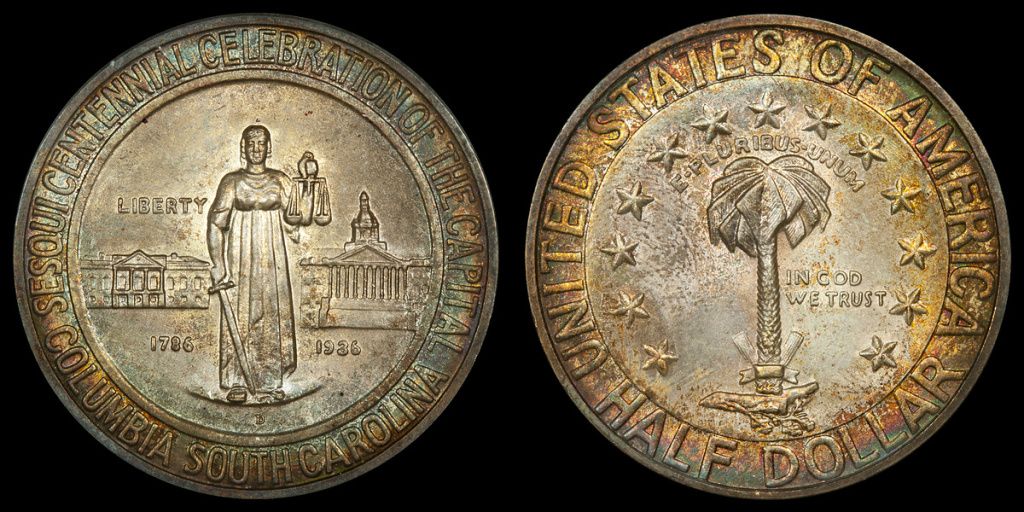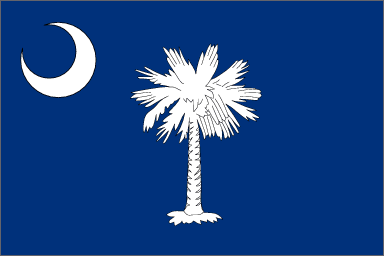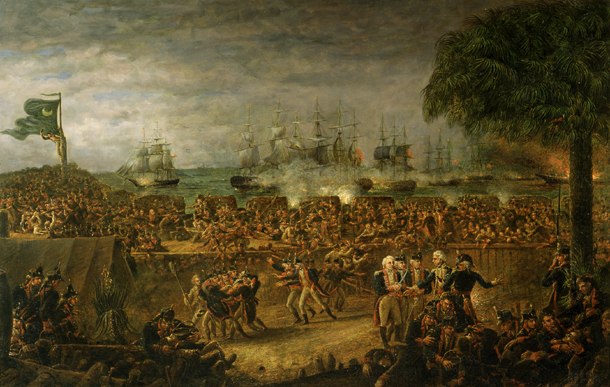f
#11 –Columbia – 1936-d

Acquired via Broadstruck from Commemdude. Photography by Messydesk
Obverse ( Justice) – rims are encircled by rings of red, aqua blue, golds and maybe a hint of purple. Aqua blue creeps into the center a bit, but for the most part the center is a really light shade of gold.
Reverse (Palmetto) – rims are encircled by golds, reds, blues and this time greens. A very pretty reverse, more vibrant then the obverse. The center has a little lighter version of the gold shading and the remnants of a finger print in the upper left quadrant of the center, no doubt from someone famous.
Stats – 25,000 total authorized to be made at the three mints. 9000 + 7 for assay at Philadelphia, 8000 + 7 for assay at San Francisco, and 8000 + 7 for assay at Denver which is where this one is from. The entire mintage was sold out quickly. (s/b)
Artist/Sculptor – A. Wolfe Davidson (s/b)
Obverse – A figure of Justice with scales and sword but as noted by s/b, no blindfold. In the background stands the Old State House to the viewers left and the New State House to the viewers right. (s/b)
Reverse – Front and center is the states emblem, the Palmetto tree. Two bunchs of arrows in a saltire pattern are tied to the tree with a ribbon and a lopped oak branch lies at the base. The thirteen stars represent the thirteen original colonies. (s/b)
Fun Facts –
I left out some of the history of the Palmetto tree reference because I wanted to detail it in further down here. Here is the reason behind the Palmetto tree being the official tree of South Carolina and also why it resides on their flag.
“On June 28, 1776, as British warships
moved to conquer the South Carolina city of
Charleston, Colonel William Moultrie and a
force of Patriot soldiers stood behind
unfinished palmetto log walls and prepared
to defend the city.
Moultrie had been warned by General
Charles Lee that the British guns would
knock his fort down around his years, but the
fiery officer replied that he would fight from
the rubble.
For nine hours Moultrie withstood the fire of
nine British warships, returning fire with
cannon shots that swept the decks of the
enemy vessels. The palmetto logs of
Moultrie's fort did not shatter from the impact
of British cannon balls, but instead the soft
logs absorbed the iron balls much as a
sponge absorbs water.
The flag of the fort was shot down at one
point, but Sergeant William Jasper braved a
storm of shot and shell to retrieve it and
return the colors to their place over the works.
In the end, Moultrie and his men prevailed.
The badly battered fleet withdrew and the fort
on Sullivan's Island became a landmark of
the American Revolution. Named Fort
Moultrie in honor of the brave colonel who
had defended it in 1776, it is a place of honor
for South Carolinians. Moultrie's blue flag
with a white crescent in the corner - with the
addition of a palmetto tree - was adopted as
South Carolina's official state flag.” Here


Charleston welcomed a shipment of golf balls and clubs from Scotland as early as 1743. On September 29, 1786, the South Carolina Golf Club was formed and, within the same year, America’s first golf course was established on Harleston Green. In 2011, there were more than 350 golf courses within the state of South Carolina. Here
In 1936 Tony Manero won the 40th U.S. Open in golf, held at the Baltusrol Golf Club in Springfield, NJ.



Acquired via Broadstruck from Commemdude. Photography by Messydesk
Obverse ( Justice) – rims are encircled by rings of red, aqua blue, golds and maybe a hint of purple. Aqua blue creeps into the center a bit, but for the most part the center is a really light shade of gold.
Reverse (Palmetto) – rims are encircled by golds, reds, blues and this time greens. A very pretty reverse, more vibrant then the obverse. The center has a little lighter version of the gold shading and the remnants of a finger print in the upper left quadrant of the center, no doubt from someone famous.
Stats – 25,000 total authorized to be made at the three mints. 9000 + 7 for assay at Philadelphia, 8000 + 7 for assay at San Francisco, and 8000 + 7 for assay at Denver which is where this one is from. The entire mintage was sold out quickly. (s/b)
Artist/Sculptor – A. Wolfe Davidson (s/b)
Obverse – A figure of Justice with scales and sword but as noted by s/b, no blindfold. In the background stands the Old State House to the viewers left and the New State House to the viewers right. (s/b)
Reverse – Front and center is the states emblem, the Palmetto tree. Two bunchs of arrows in a saltire pattern are tied to the tree with a ribbon and a lopped oak branch lies at the base. The thirteen stars represent the thirteen original colonies. (s/b)
Fun Facts –
I left out some of the history of the Palmetto tree reference because I wanted to detail it in further down here. Here is the reason behind the Palmetto tree being the official tree of South Carolina and also why it resides on their flag.
“On June 28, 1776, as British warships
moved to conquer the South Carolina city of
Charleston, Colonel William Moultrie and a
force of Patriot soldiers stood behind
unfinished palmetto log walls and prepared
to defend the city.
Moultrie had been warned by General
Charles Lee that the British guns would
knock his fort down around his years, but the
fiery officer replied that he would fight from
the rubble.
For nine hours Moultrie withstood the fire of
nine British warships, returning fire with
cannon shots that swept the decks of the
enemy vessels. The palmetto logs of
Moultrie's fort did not shatter from the impact
of British cannon balls, but instead the soft
logs absorbed the iron balls much as a
sponge absorbs water.
The flag of the fort was shot down at one
point, but Sergeant William Jasper braved a
storm of shot and shell to retrieve it and
return the colors to their place over the works.
In the end, Moultrie and his men prevailed.
The badly battered fleet withdrew and the fort
on Sullivan's Island became a landmark of
the American Revolution. Named Fort
Moultrie in honor of the brave colonel who
had defended it in 1776, it is a place of honor
for South Carolinians. Moultrie's blue flag
with a white crescent in the corner - with the
addition of a palmetto tree - was adopted as
South Carolina's official state flag.” Here


Charleston welcomed a shipment of golf balls and clubs from Scotland as early as 1743. On September 29, 1786, the South Carolina Golf Club was formed and, within the same year, America’s first golf course was established on Harleston Green. In 2011, there were more than 350 golf courses within the state of South Carolina. Here
In 1936 Tony Manero won the 40th U.S. Open in golf, held at the Baltusrol Golf Club in Springfield, NJ.


0